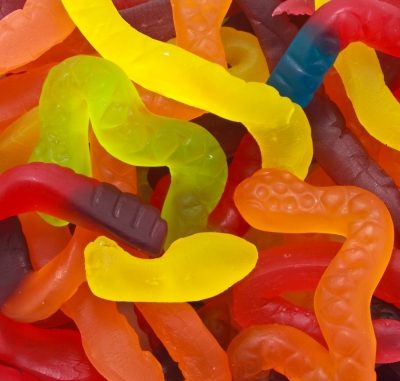
Introduction
Children especially love the packets of chewy, colourful and sweet gummy bears. These have a long history in modern confectionary. They were originally invented by the German, Hans Riegel in the early 1920s using gelatin because it produced such a good elasticity in the gum sweets he developed. His business developed into that famous brand name Haribo and gummy/gummi confectionary became its main stay.
In the 1960s, many of these sweets were imported into the USA. From a US point of view, the Goelitz Candy Company and the Brock Candy Company both claim to have produced their own gummy bear candy in the 1980s.
Shapes for these gummies are fabulous in range, colour and size. We know they come in both sweet and sour flavours and no fruit type has not been tried. Gelatin is the key ingredient here but non-gelatin confectionary has been developed to satisfy vegetarian requirements although to date the types of gel used have not yet matched the quality of elasticity that gelatin provides.
The basic gummy candy recipe without sugar is the following:-
Ingredients:
- 1/3 – 1/2 cup cold water
- 1 package flavored gelatin
- 4 packets unflavored gelatin
Preparation:
- Prepare the gelatin as per the makers instructions. Pour cold water into a heatproof glass measuring beaker with a spout. Sprinkle the gelatin on the surface and stir with a spatula preferably rubber. A thick jelly-like mass is created but this must continue to be stirred. Ensure all the pieces of gelatin are dissolved including the bits on the side of the spatula.
- Cover the beaker with plastic wrap and let the gelatin mass settle for 10 minutes.
- In a medium-sized saucepan, half fill it with water and heat to a point where water is simmering with small pointed bubbles.
- Place the bowl containing the gelatin mass in the water. Let the gelatin mass melt to a form a viscous solution with gentle stirring. A clear solution should form.
- With a clear solution, turn down the heat and let rest for 2 minutes.
- Pour the hot mixture from the measuring bowl into moulds. When the solution becomes too sticky, reheat to reduce its viscosity. When the candies contract in their moulds it is possible to add further solution to fill in the gaps.
- Place the moulds in the freezer for 10 minutes and then finish off in a fridge.
- Remove from the moulds.
In the manufacturing sense, the gummy candy often contains more sophisticated ingredients. A good base example for a sugar-free gummy bear is the following:-
- Isomaltitol (60g)
- 75% Maltitol solution (330g)
- Corn modified starch (160g)
- Gelatin (260g)
- Pectin (4g)
- Gellan gum (0.6g)
- Citric acid anhydrous (8g)
- Malic acid (3g)
- Fruit flavour (4g)
- Colour (0.01g)
The colour and flavour can be anything but should be the smallest in quantity of the ingredients. The base gummy formulation is ideal for manufacture. Gummy candies often get their shiny look by finishing with a high quality wax dispersed in oil. Carnauba wax is probably the best for this.
All these ingredients are added before forming. The methods of forming vary widely depending on the candy. The most common method of forming a gummy or jelly candy is created by dropping the fluid mass into impressions made in a dried corn starch in a starch mogul. The candy is allowed to set in the drying starch. Starchless molding is also used for certain gummy candy.
Its worth comparing the manufacture to soft gels.
Products
Please read our affiliate disclosure.
I could eat gummy bears for the USA all day. Bought a bag and it lasted just 30 seconds.
I think gummy bears are ideal for alcoholic drink flavours!